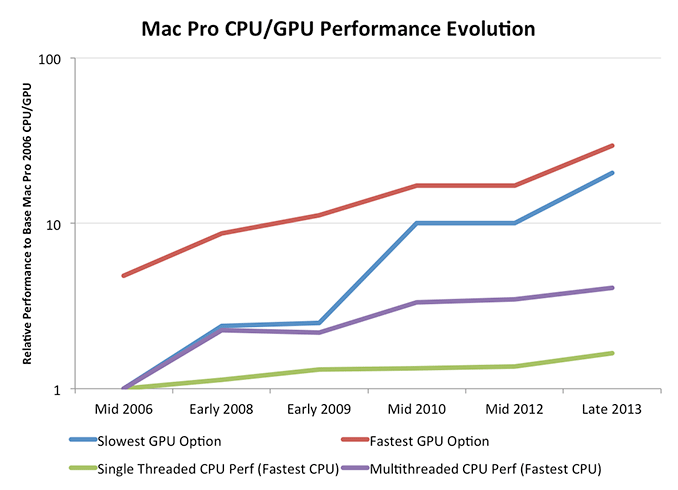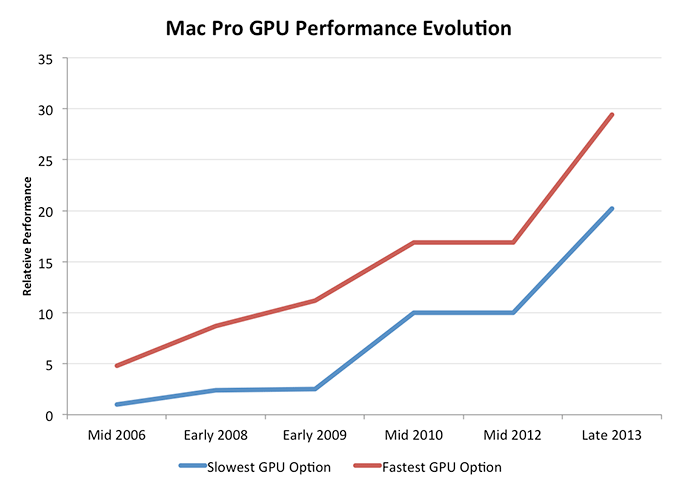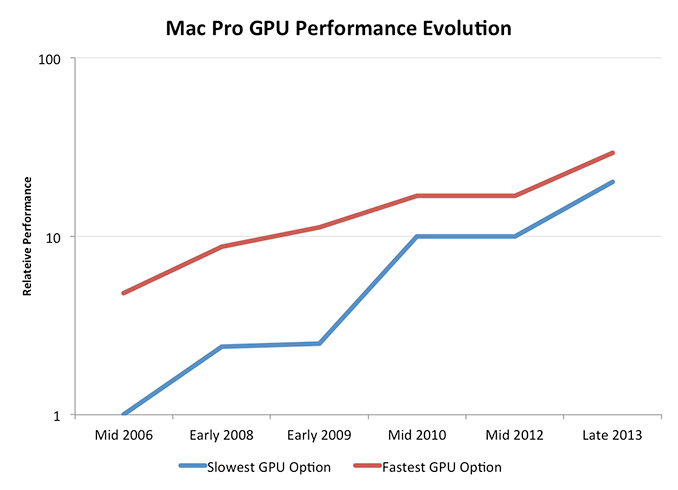The Mac Pro Review (Late 2013)
by Anand Lal Shimpi on December 31, 2013 3:18 PM ESTPlotting the Mac Pro’s GPU Performance Over Time
The Mac Pro’s CPU options have ballooned at times during its 7 year history. What started with four CPU options grew to six for the early 2009 - mid 2010 models. It was also during that time period that we saw an expansion of the number of total core counts from 4 up to the current mix of 4, 6, 8 and 12 core configurations.
What’s particularly unique about this year’s Mac Pro is that all configurations are accomplished with a single socket. Moore’s Law and the process cadence it characterizes leave us in a place where Intel can effectively ship a single die with 12 big x86 cores. It wasn’t that long ago where you’d need multiple sockets to achieve the same thing.
While the CPU moved to a single socket configuration this year, the Mac Pro’s GPU went the opposite direction. For the first time in Mac Pro history, the new system ships with two GPUs in all configurations. I turned to Ryan Smith, our Senior GPU Editor, for his help in roughly characterizing Mac Pro GPU options over the years.
| Mac Pro - GPU Upgrade Path | ||||||||||
| Mid 2006 | Early 2008 | Early 2009 | Mid 2010 | Mid 2012 | Late 2013 | |||||
| Slowest GPU Option | NVIDIA GeForce 7300 GT | ATI Radeon HD 2600 XT | NVIDIA GeForce GT 120 | ATI Radeon HD 5770 | ATI Radeon HD 5770 | Dual AMD FirePro D300 | ||||
| Fastest GPU Option | NVIDIA Quadro FX 4500 | NVIDIA Quadro FX 5600 | ATI Radeon HD 4870 | ATI Radeon HD 5870 | ATI Radeon HD 5870 | Dual AMD FirePro D700 | ||||
Since the Mac Pro GPU offerings were limited to 2 - 3 cards per generation, it was pretty easy to put together comparisons. We eliminated the mid range configuration for this comparison and only looked at scaling with the cheapest and most expensive GPU options each generation.
Now we’re talking. At the low end, Mac Pro GPU performance improved by 20x over the past 7 years. Even if you always bought the fastest GPU possible you'd be looking at a 6x increase in performance, and that's not taking into account the move to multiple GPUs this last round (if you assume 50% multi-GPU scaling then even the high end path would net you 9x better GPU performance over 7 years).
Ryan recommended presenting the data with a log scale as well to more accurately depict the gains over time:
Here you see convergence, at a high level, between the slowest and fastest GPU options in the Mac Pro. Another way of putting it is that Apple values GPU performance more today than it did back in 2006, so even the cheapest GPU is a much higher performing part than it would be.
If you’re a GPU company (or a Senior GPU Editor), this next chart should make you very happy. Here I’m comparing relative increases in performance for both CPU and GPU on the same graph:
This is exactly why Apple (and AMD) is so fond of ramping up GPU performance: it’s the only way to get serious performance gains each generation. Ultimately we’ll see GPU performance gains level off as well, but if you want to scale compute in a serious way you need to heavily leverage faster GPUs.
This is the crux of the Mac Pro story. It’s not just about a faster CPU, but rather a true shift towards GPU compute. In a little over a year, Apple increased the GPU horsepower of the cheapest Mac Pro by as great of a margin as it did from 2006 - 2012. The fastest GPU option didn’t improve by quite as much, but it’s close.

Looking at the same data on a log scale you’ll see that the percentage increase in GPU performance is slowing down over time, much like what we saw with CPUs, just to a much lesser extent. Note that this graph doesn't take into account that the Late 2013 Mac Pro has a second GPU. If we take that into account, GPU performance scaling obviously looks even better. Scaling silicon performance is tough regardless of what space you’re playing in these days. If you’re looking for big performance gains though, you’ll need to exploit the GPU.
The similarities between what I’m saying here about GPU performance and AMD’s mantra over the past few years aren’t lost. The key difference between Apple’s approach and those of every other GPU company is that Apple spends handsomely to ensure it has close to the best single threaded CPU performance as well as the best GPU performance. This is an important distinction, and ultimately the right approach.













267 Comments
View All Comments
FunBunny2 - Tuesday, December 31, 2013 - link
Has everybody forgotten? This is just a Cube with one round corner. I suppose Tim will claim that's been patented too.newrigel - Wednesday, March 1, 2017 - link
Right.... with a unified core in it he he.... Mac's ruleY0ssar1an22 - Tuesday, December 31, 2013 - link
Off the Mac Pro topic but how come the 2013 13" rMBP scores significantly lower than the 2012 and various MBAs in the Cinebench 11.5? I'm personally interested as I have one on order :-) It scores better in later tests (so presumably not a typo?) Cinebench caught my eye as the first cross-benchmark in the review.Thanks for this review, and looking forward to the rMBPs in depth!
iwod - Tuesday, December 31, 2013 - link
1. What are the likely chances of a Mac that does Desktop Class Gfx card with 2 x8 PCI-E and uses Desktop Haswell instead. Unless i miss anything surely this is a simple change in production line.2. SSD speed is slow, for a Peak rate of 2GB/s, it seems Apple firmware or Samsung Controller not capable of feeling up the peak bandwidth? So which is likely the cause?
3. GFx ECC Ram. How much of a problem is it? For Professional market? And why Apple decide to ditch this since the price difference are minor for the price of Mac Pro.
dwade123 - Tuesday, December 31, 2013 - link
Who the **** put a trashcan here!?e375ued - Wednesday, January 1, 2014 - link
Is there some convenient reason Anand let the Mac Pro off easy by using Prime95 instead of Intel Burn Test or linpack?Ryan Smith - Wednesday, January 1, 2014 - link
It was my suggestion to try maxing out the Mac Pro, just to see if it would throttle (and if so, by how much). I picked Prime95 because it's good enough; not that there's anything wrong with IBT or Linpack, but all 3 of those are close enough that it shouldn't matter (and P95 is easy to use).jrs77 - Wednesday, January 1, 2014 - link
Good test that shows that the thermal core design works like a charm, even when applying very heavy and rather unrealistic loads to the system.Most people will run these new Mac Pros with only having a scene rendered or a video-filter applied etc and in this case the system is basically dead-silent and street-noise totally drowns the noise of the fan anyways.
Just a tad too expensive for me tho.
Kevin G - Wednesday, January 1, 2014 - link
The ‘mid range’ config is a far better value on the 2012 model since it is a 12 core model. The $200 savings can be put toward a better GPU.With regard to Cinebench, does it use AVX under OS X? I suspect that it does and that is where the majority of the single threaded CPU performance increase comes from. I strongly suspect that the single threaded performance advantage is far narrower in legacy code that doesn’t take advantage of AVX.
I’m glad the 2012 model was tested with a Radeon 7950. The ability to upgrade GPU’s matters and it’ll keep the 2012 model competitive for awhile. The system will support future video cards that come in from the PC side of things. With UEFI on video cards now, there is little difference between a Mac and PC version. For what it is worth, I have stuck an EVGA GTX 770 into a 2012 Mac Pro without issue and no modification on the video card or OS X drivers. It just works.
A bit of a random note is that the GPU connector used in the Mac Pro isn’t new to Apple: they used it for the G4 class daughter cards form 15 years back.
The PLX chip doesn’t have to do any port switching as a single GPU can drive up to 6 surfaces. That would imply the six DP signals from one GPU are routed in pairs to each of the Falcon Ridge controllers for encapsulation.
One shocking thing is that wall power draw exceeds that of the PSU’s DC rating. That is worrying as the system itself has only a 450W rated power supply. Due to the AC to DC conversion, there is an efficiency factor but the system has to be running close to its DC limit. Performing several file transfers over powered Thunderbolt devices could put the power draw beyond the rated DC limit. I wonder if Apple has implemented throttling based upon raw power consumption of the system as a whole in addition to temperature and power consumption of individual parts. Perhaps testing the system on a 240V AC circuit would alter things here as it is more efficient power delivery?
One aspect not accounted for is memory expansion. The 2009/2010/2012 Mac Pro’s will work with registered ECC memory which brings their maximum capacity up to 128 GB. Memory bandwidth too is superior in the dual socket 2010/2012 models: six channels of 1333 Mhz memory does have more bandwidth than four channels at 1866 Mhz. Going multi-socket does carry some overhead but still a bit of a disappointment that the theoretical number didn’t improve.
Bill Thompson - Wednesday, January 1, 2014 - link
My guess is the nVidia-based iMac is faster with After Effects and Premiere because of CUDA.Davinci Resolve has been updated for OpenCL, but I don't think Octane or Adobe apps have.
BTW, FCP X 10.1 displays multiple 4K streams in real time without rendering. It's a serious app.